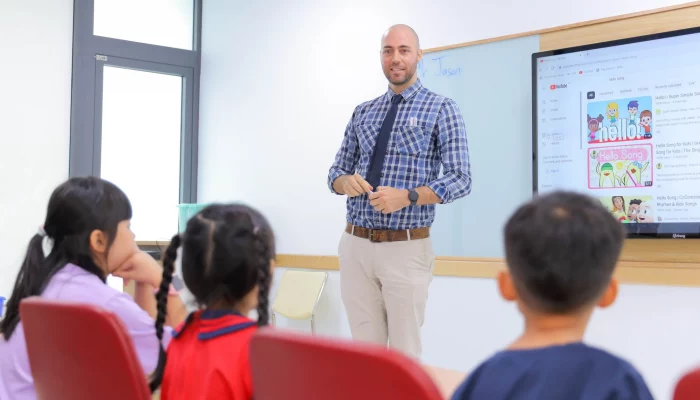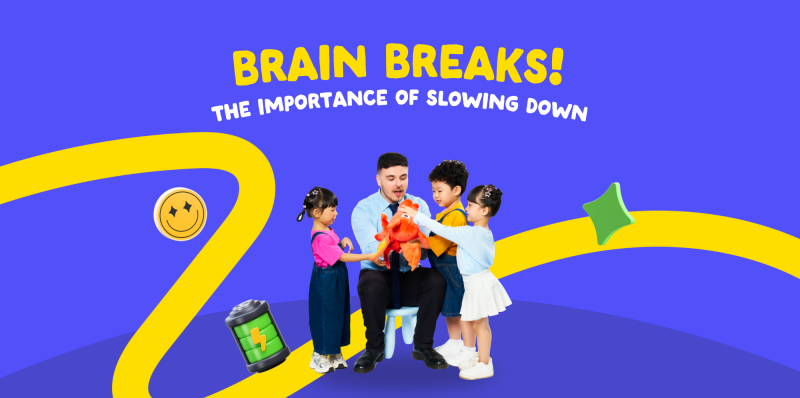In the fast-paced environment of an ESL classroom, teachers often feel the pressure to keep lessons moving swiftly-after all, every minute counts. However, the reality is that young learners (and even teens) can only focus for so long before their attention begins to drift. That’s where brain breaks come in.
Brain breaks are short, structured pauses that allow students to reset mentally and physically. They give young learners a chance to release energy, refocus their attention, and approach the next part of the lesson with renewed enthusiasm. And they’re not just beneficial for students-teachers and teaching assistants (TAs) can use these moments to breathe, observe, and prepare for what’s next.
Table of Contents
Why Brain Breaks Matter
At this age, your students’ ability to sustain attention is limited, and after about 10–15 minutes of focused learning, they naturally need a change in pace or activity to re-engage. This is simply because their brains are still developing. A quick brain break acts like a reset button, giving them a chance to recharge and return to the lesson with fresh energy. This leads to better concentration, improved memory, and a more positive attitude toward learning.
But here’s the bonus: brain breaks aren’t just for students – they’re for you, too! As a teacher, a short break gives you a moment to regroup, check your lesson materials, or simply catch your breath. It also helps you prevent classroom restlessness from escalating into disruption. In short, brain breaks keep your students happy and learning, while giving you the space to teach more effectively.
TAs play a vital role in this process. They can lead quick activities, monitor students’ engagement during the break, and assist in smoothly transitioning back to the main lesson. Brain breaks work best when everyone in the room – the teacher, TA, and students – understands their purpose and participates together.



Types of Brain Breaks
Quick Movement Games:
Movement-based breaks are perfect when students are getting fidgety, losing focus, or showing signs of low energy. A short burst of physical activity helps them release tension and reawaken their concentration.
- How to do it: Announce a fun, simple activity such as “Simon Says” or “Stand Up If…” Keep the rules short and easy to follow – focus on movement rather than competition. Limit the game to one or two minutes, then guide the class back to calm.
- TA’s role: The TA can demonstrate the actions alongside the teacher or monitor students at the back of the room to ensure everyone participates safely. They can also manage transitions – helping students sit back down quietly and prepare for the next task.
- Benefit: Physical brain breaks help reset students’ energy and focus levels, while also giving the teacher and TA a chance to gauge the class’s mood before continuing.
Mini Competitions:
Short, light-hearted competitions can re-engage students when motivation starts to fade. They work well after a long listening or reading task, when students need a mental refresh.
- How to do it: Choose a quick challenge related to the lesson – like a spelling bee, vocabulary recall, or “Who can make a sentence first?” game. Keep it friendly and rotate participants often. Offer simple rewards such as stickers or team points for enthusiasm and effort.
- TA’s role: The TA can act as a co-host – keeping score, handing out small rewards, or encouraging quieter students to participate. They can also support students who need language scaffolding during the game.
- Benefit: These mini competitions promote healthy participation, teamwork, and confidence while providing teachers with a natural transition between two lesson segments.

Breathing or Mindfulness Moments:
When a class feels noisy or overstimulated, a calm and quiet brain break can work wonders. Mindfulness activities teach students self-regulation and help restore a sense of calm before a new activity.
How to do it: Have students close their eyes (if appropriate) or look down at their desks. Guide them through a slow, simple breathing exercise: “Inhale through your nose… exhale through your mouth…” Repeat 3–4 times, keeping your voice calm and steady.
TA’s role: The TA can model calm behavior by following along and ensuring that students are participating respectfully. They can also assist individual students who have difficulty staying still or understanding the instructions.
Benefit: These quiet breaks promote emotional control, reduce stress, and create a smoother transition into the next learning task. Teachers also gain a brief pause to reset their own tone and energy.
Quick Movement Games:
Not all breaks have to be energetic or competitive. Sometimes, a few minutes of creativity allows students to decompress while staying mentally engaged.
How to do it: Provide students with a quick creative prompt: “Draw what you learned today” or “Sketch your favorite animal using three colors.” Allow them two to three minutes to complete the task. Invite a few volunteers to share their drawings or ideas briefly.
TA’s role: The TA can circulate around the classroom to offer encouragement or help students who are unsure what to do. They can also help manage time so the activity ends smoothly.
Benefit: Creative breaks allow students to express themselves, reinforce learning in a visual way, and provide teachers with valuable insights into student comprehension – all while restoring calm focus to the classroom.
How to Use Them Effectively
Brain breaks are most effective when they are intentional, short, and well-timed. They shouldn’t feel random or unrelated to the flow of your lesson. A good rule of thumb is to use one short break every 15–20 minutes for young learners and every 30 minutes for older students. Brain breaks don’t need to be long! Anywhere from 2-5 minutes is long enough to reset.
Recognizing when to use a brain break: Be alert to these common signs that your students need a pause:
- Students are fidgeting, yawning, or chatting more than usual.
- The room feels unusually quiet or flat, showing low energy.
- You’re repeating instructions more than once because students aren’t responding.
- Activities that normally go smoothly suddenly feel harder to manage.
When these signs appear, it’s often more effective to pause briefly than to push forward. Even a two-minute activity can restore attention far better than five minutes of struggling through disengagement.


Balancing energy:
Consider alternating between active and calm breaks. After an intense activity like a group game, a quiet breathing break may be more effective. Conversely, after a long reading section, an energetic game can reawaken focus.
TA involvement:
TAs can be instrumental in identifying when a break is needed. They often notice subtle changes in student behavior before the teacher does. Encourage open communication – TAs can quietly suggest a quick break or take the lead in running one. This teamwork ensures that breaks feel natural and efficient rather than disruptive.
Encore: Take a Break, Make a Difference
Brain breaks are more than just filler activities – they’re powerful tools for keeping your students engaged, motivated, and ready to learn. And don’t forget, they also give you the space to recharge and reset. The next time you notice your class starting to fade, hit pause. A few minutes of fun could make all the difference for the rest of the lesson – for your students and for you.
For nearly 30 years of pioneering English education in Vietnam, VUS has built a strong reputation with 68 campuses and more than 2,700 internationally qualified teaching staff nationwide.
VUS proudly affirms its leading position with a double victory at the Vietnam Technology Excellence Awards 2025, and two consecutive years being honored as an Inspirational Brand at APEA, alongside many other prestigious national and international awards.
When joining VUS, teachers and teaching assistants enjoy a wide range of practical benefits that support long-term growth and commitment:
- Stable income: Steady and fair rewards for your efforts, allowing you to focus fully on teaching and growth.
- Ongoing professional training: Structured onboarding with the Entrance Workshops and continuous support via sharing sessions and the Training Hub, led by Teaching Quality Managers with 100% holding master’s or doctoral degrees and extensive teaching experience.
- Modern, international-standard facilities: Diverse teaching tools, updated materials, and fully equipped classrooms for a professional working environment.
- Engaging internal events: Activities that create opportunities to relax, connect with colleagues, and recharge your energy.
- Supportive colleagues: Work with a team that is always ready to share, support, and grow together.
Clear career advancement: A transparent career path with many opportunities to challenge yourself and grow into higher roles.



VUS offers a workplace full of opportunities, where you can strengthen your skills, affirm your value, and inspire Vietnam’s young generation:
- Expatriate Teachers: Experience teaching in Vietnam with international standards, full integration support, and career development opportunities.
- Vietnamese Teachers: Continuously sharpen your expertise while helping students reach out to the world.
- Teaching Assistants: The perfect first step to explore the teaching profession and gain valuable real-life classroom experience.
Start your teaching journey with VUS today!


